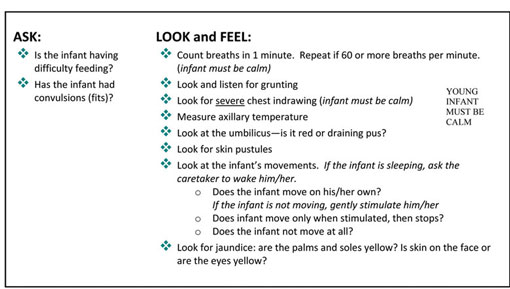Initial visit assessment
To assess a young infant you should:
- Check for signs of possible bacterial infection and jaundice.
- Ask about diarrhoea. If the infant has diarrhoea, assess the related signs, including whether the young infant is dehydrated. Also classify whether the diarrhoea is persistent and whether dysentery is present (you will learn how to assess for dysentery in Study Session 5 of this Module).
- Check for feeding problems or low weight. This includes assessing breastfeeding (which you will learn in Study Session 5 of this Module).
- Check the young infant’s immunization status (which you will learn in Study Session 12 of this Module).
- Assess any other problems, for example birth trauma and birth defects.
If it is clear that a young infant needs urgent referral, because you have classified serious bacterial infection or jaundice or another serious illness, there may not be time to do the breastfeeding assessment.
You need to be aware of the importance of assessing the signs in the order set out in Box 3.1 below, and to keep the young infant calm while you do the assessment. The young infant may be asleep while you assess the first three signs: that is, counting breathing, looking for chest in-drawing and grunting. When you assess the signs in relation to the umbilicus, temperature, skin pustules and jaundice, you will need to pick up the infant and then undress him, so that you can look at the skin all over his body and measure his temperature. By this time he will probably be awake so you can then observe his movements.
Box 3.1 sets out the steps you need to take to assess the young infant for bacterial infection and jaundice at the initial visit.
Box 3.1 How to check for possible bacterial infection and jaundice at an initial visit

You are now going to look at each of these steps in more detail, first in relation to assessing for bacterial infection.